AI tools can turn a one-line idea into a full story draft in seconds
But you have to know which AI tool fits your scriptwriting goal.
In this guide, we’ll walk through the best solutions right now, focusing on what each actually does well for storytellers.
| # | Tool (link) | Best for | What it does well | Pricing snapshot* |
|---|---|---|---|---|
| 1 |
Subscribr
YouTubeVoice profiling
|
YouTube creators optimizing scripts for retention & SEO | “Idea → script” chat workflow; titles/hooks/keywords; channel & trend research; brand voice profiles; export to Docs/Word | Creator ≈ $49/mo · Automation ≈ $99/mo · Scale ≈ $299/mo · entry tier ~ $14.83/mo |
| 2 |
Claude / Gemini / ChatGPT
General LLMLong context
|
Outlines, beat sheets, character passes, quick alternates | Very long context windows; strong outlining (Claude), rapid iteration (ChatGPT), multimodal briefs (Gemini) | ChatGPT Plus $20/mo; Claude Pro $20/mo (~$17/mo annually); Gemini Advanced ~$19.99/mo |
| 3 |
FinalBit
All-in-one film suite
|
Production-minded writers (breakdowns, scheduling, budgeting) | Smart formatting/“Script Doctor”; scene breakdown to cast/props/locations; project management | Contact sales / tiered (creator → team → enterprise) |
| 4 |
Saga
Storyboard/PrevizTemplates
|
Narrative templates + quick storyboard panels | Beat-sheet frameworks; integrated storyboard/visual refs; exports (.fdx/Fountain); collaboration | Free starter; Premium ≈ $19.99/mo (with monthly image/video credits) |
| 5 |
Melies AI
Pre-productionAssets
|
Ideas → script → images/voices in one place | Screenwriting + asset generation (images/video/audio); character bibles; exports (.fdx/Fountain/PDF) | Indie ≈ $29/mo · Filmmaker ≈ $99/mo · Studio ≈ $390/mo (credit-based) |
| 6 |
Squibler
Author/Long-formTemplates
|
Longer narrative projects with characters/settings/scenes | Screenplay templates; AI scene generation; element management; DOCX/PDF export | Free (limited). Pro ≈ $16–29/mo depending on billing |
| 7 |
Synthesia
Text-to-VideoMultilingual
|
Fast script → avatar video & localization | AI script generator + 140+ languages; templates; branding kits; collaboration | Free (limited). Starter ≈ $29/mo; Creator ≈ $89/mo; Enterprise custom |
1. Subscribr
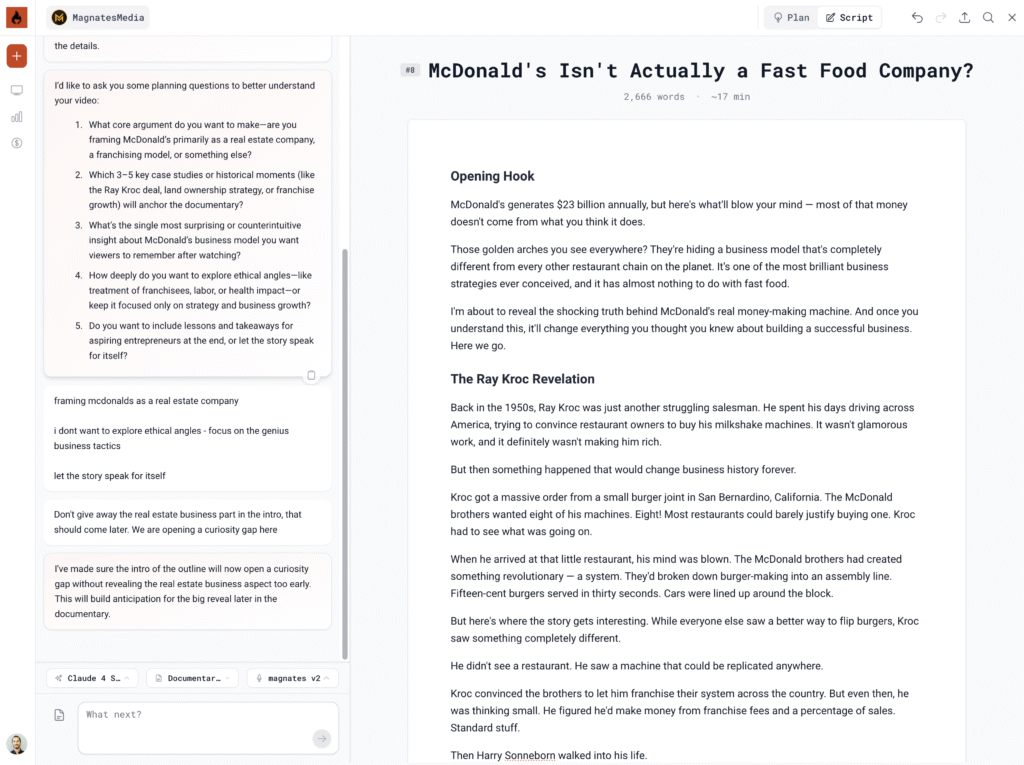
Subscribr is a AI-powered platform dedicated to script writing and designed with YouTube creators in mind. You feed it your video topic, target audience, style, and it helps generate titles, hooks, outlines, and full drafts of scripts.
Key Features
- Idea to script workflow: You start with a video “seed” (topic or idea), the AI chats with you to refine goal & style, then generates the script. “Chat to script” is built-in.
- Voice and brand profiling: Subscribr will learn how you write and speak (or at least how you want to) so scripts sound like you.
- Research & trend-analysis tools: It allows you to analyze YouTube channels, videos, and content gaps so your scripts are built on data, not guesswork.
- Script formatting and export: Once the draft is ready, you export to Word/Google Docs or use it directly in production.
- YouTube-specific optimisations: Titles, hooks, tags, keywords—all within the same environment. That means your script isn’t just written—it’s optimised for search and engagement.
Script Quality
- Because the tool is YouTube-specific, it introduces storytelling, hook systems, and structure formats designed for retention. For instance, some users saw increases in average view duration after switching to the platform.
- The voice-profile feature helps the output avoid “generic AI tone”—which means fewer mechanical phrases and more content that aligns with your brand.
- However: it’s still AI output. You’ll need to perform your human editing pass—checking tone, verifying facts, injecting your insights or anecdotes.
Pricing
Here’s a snapshot of how Subscribr is priced (numbers sourced publicly; always check latest details).
- Creator Plan: approximately US $49/month for 2 channels and ~10–12 scripts per month when billed monthly.
- Automation Plan: about US $99/month for 5 channels, ~20–25 scripts/month.
- Scale Plan: around US $299/month for unlimited channels, ~400 script credits/month.
- Entry-level/Ideation Plan: Some sources list a starting tier ~US $14.83/month (for minimal scripts) according to SaaSworthy.
2. Claude, Gemini and ChatGPT

The three leading general-purpose LLMs can work really well for script writing.
What they are
- Anthropic Claude is Anthropic’s assistant and API lineup, known for large context windows and strong instruction following. Recent Sonnet and Opus versions target long documents and agentic tasks.
- Google Gemini is Google’s native-multimodal family of models available in the Gemini app and through Google One’s “AI” plans. Current flagship tiers expose long-context models in the consumer app and the API.
- OpenAI ChatGPT is OpenAI’s assistant product that gives you access to their newest multimodal GPT models inside a chat UI, plus tools like file uploads and projects.
Script Features
- Very long context. All three vendors now advertise million-token class windows, which is useful when you paste a beat sheet, character bios, and prior drafts in one go.
- Gemini 2.5 Pro ships with a 1M token context window, with a 2M target on the roadmap.
- Claude Sonnet 4,5 supports up to 1M tokens in the API.
- OpenAI’s GPT-5 for ChatGPT and API also moved to 1M tokens for paid users.
- Ecosystem and export. None of the three is a full screenwriting studio by default. Their value is ideation, outlining, character passes, line-by-line punch-ups, and notes.
Script quality
Quality varies by prompt, by constraints, and by the kind of script.
- Outlining and structure. Claude often shines when you ask for scene-by-scene breakdowns, beat restructuring, and thematic consistency. Independent testers and writing coaches frequently praise Claude’s “warm” prose and patient reasoning, which reads well in dialogue and stage direction.
- Rapid ideation and iteration. ChatGPT is versatile and fast for “ten loglines,” “three alternate cold opens,” or “punch up this dialogue for rhythm.” The latest GPT models in ChatGPT also handle long context, so you can keep the whole draft in memory during revisions.
- Research-heavy work or mixed media prompts. Gemini’s native multimodality and long context are helpful when you want to feed reference images, marketing briefs, or research excerpts and ask for a draft that stays aligned to those inputs.
A few grounded expectations for you as a scriptwriter or marketer:
- Formatting. None of the three reliably outputs industry-perfect screenplay formatting without guidance. Use strict templates or move the text into Final Draft, Highland, or a purpose-built tool for sluglines and pagination.
- Voice and clichés. All three can fall back to generic beats and phrasing. You will need a human pass to avoid flat arcs or on-the-nose dialogue.
- Rewriting workflow. Best results come from a loop: outline constraints, draft, ask for alternatives on a single scene, then rewrite with notes rather than regenerate the whole script.
Pricing
- ChatGPT
- Plus is listed at $20/month for individuals. Pro is listed at $200/month with higher limits and features. Team and Enterprise plans exist for collaboration and governance. Check country pricing before you budget.
- Claude
- Pro is $20/month if billed monthly, or $17/month when billed annually. Team and Enterprise tiers add collaboration and admin controls.
- Gemini (consumer access)
- Google One AI Premium / Google AI Pro bundles “Gemini Advanced” access at $19.99/month in many markets. Carriers and partners sometimes discount it in bundles, which confirms the base price.
3. FinalBit
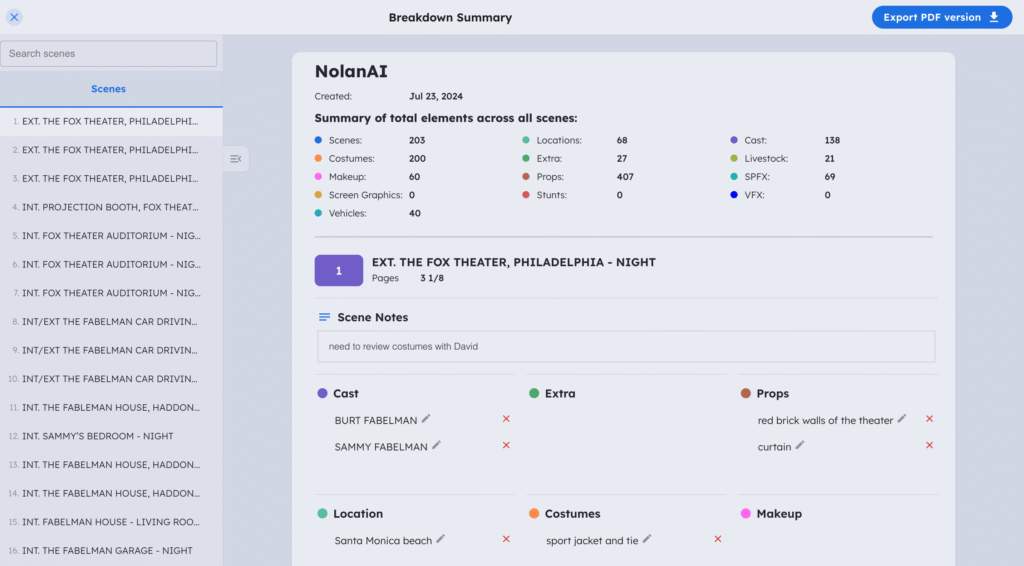
FinalBit is an all-in-one AI filmmaking and pre-production platform. It isn’t just about writing dialogue or beats: it covers concept creation, script drafting, formatting (“smart formatting”), scheduling, budgeting, storyboarding and even more.
Key Features
- Smart Script Formatting & Doctoring: FinalBit includes a “Script Doctor” module that suggests formatting improvements, corrects structure, and helps turn raw draft into a cleaner screenplay-style document.
- Scene Breakdown & Pre-Production Tools: Once your script is drafted, FinalBit can break it down into cast, props, location lists, schedule items—so you move from writing to action planning.
- Storyboard, Visual Planning & Agent-Assisted Workflows: The platform supports storyboard generation, camera/shot suggestions and collaborative pre-viz elements that help when you’re producing content, not just writing it.
- Project Management & Collaboration: Since the tool covers full projects, it supports versioning, collaboration, and review features—helpful when you have a team or external talent.
- Brand & Content Marketing Use-Case: While many tools focus purely on narrative film, FinalBit offers value where your script sits within a broader content chain: video campaign, marketing film, branded short, etc.
Script Quality
What works well:
- The tight integration between drafting and production planning means your script won’t live in isolation. You draft with production in mind—locations, actors, props, timing—rather than late-stage conversion.
- Smart formatting reduces the “this still needs to be exported into Final Draft” overhead. That saves time.
- The logic for scene-by-scene breakdown means your scripts tend to be more structured and actionable for video teams.
Where you’ll still need human input:
- Like all AI tools, FinalBit’s “generic” text is just a start. If you want your brand voice—your tone, your specific audience insight—you’ll need a human edit pass.
- For highly emotional, deeply human dialogue or ultra-creative arcs (e.g., branded narrative with subtext), the tool gives you structure, but you supply the nuance.
- If you operate with very short scripts (30-60 sec social ads) the full production suite might be over-engineered compared to a simpler tool—but the features are still beneficial for scaling.
Pricing
- FinalBit lists itself as an all-in-one filmmaking suite, which means the pricing is higher than simple script-writers.
- I couldn’t locate a detailed public breakdown as comprehensive as some other tools; you’ll typically engage via a “contact sales” or tier-based model for creators, production teams and enterprise.
- Because it covers script writing + pre-production + collaboration, you should budget accordingly: for example, a small team plan may cost several tens of dollars per month; larger production/enterprise tiers will scale.
- Practical advice: If you’re a solo content marketer producing regular films, ask for a “Creator” plan or “Small production” tier—compare cost vs output (number of scripts per month, number of scenes, export/rendering features).
4. Saga
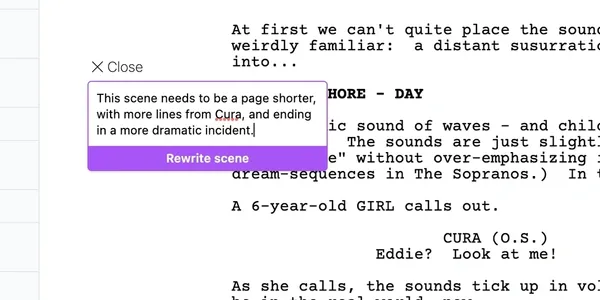
Saga is an AI-driven platform designed to take you from initial concept through scene drafting and visualisation. It supports everything: logline → character beats → full script → storyboard/previz.
Key Features
- Script Assistant & Beat Sheet Templates: Saga gives you structured narrative frameworks (feature films, TV series, short films) so you’re not just writing text but following story architecture.
- AI Storyboard & Pre-visualisation: Once scenes are drafted, you can generate storyboard panels or even short animatic previews. The platform supports camera/shot planning, scene numbering and visual notes.
- Multi-model engine: The tool integrates multiple generative engines (text + image + video) so your output isn’t limited to dialogue — you get visual references too. Example: 40 images or 4 videos per month in some tiers.
- Export & collaboration: Upload or export your script drafts (Final Draft .fdx, Fountain format), version control and team collaboration built in.
Script Quality
Strengths:
- The narrative templates add discipline: if you’re doing campaign video scripts with arcs, sub-stories, B-roll, Saga reduces drafting time.
- The integrated visuals mean the script isn’t divorced from production. When you’re writing branded story videos, marketing films or multi-stage sequences, having storyboard support in the same tool helps.
- Real writers (filmmakers) report that Saga’s prompts and models feel more film-industry aligned than generic LLMs.
Limitations:
- The platform has more moving parts — script, storyboard, previz — which means more complexity. If you’re just writing short social video scripts (2-3 minutes, one scene), the extra features may not add value.
- The AI still needs your human edit: voice, brand alignment, dialogue tone, audience fit. It generates strong scaffolding; you polish the personality.
- Exported drafts may still need further formatting or conversion before publication or editing in specialist tools.
Pricing
- Free / starter: Basic access available for writing “Plot”, “Character”, “Acts” pages; limited image/video credits.
- Premium Plan: Approximately US $19.99/month (with 3-day free trial) gives full access: unlimited text generation, advanced storyboard & script editor, limited monthly image/video credits (e.g., 40 images or 4 videos).
- Team / Enterprise: Custom quoting for large teams, higher volume image/video generation, custom model access.
5. Melies AI
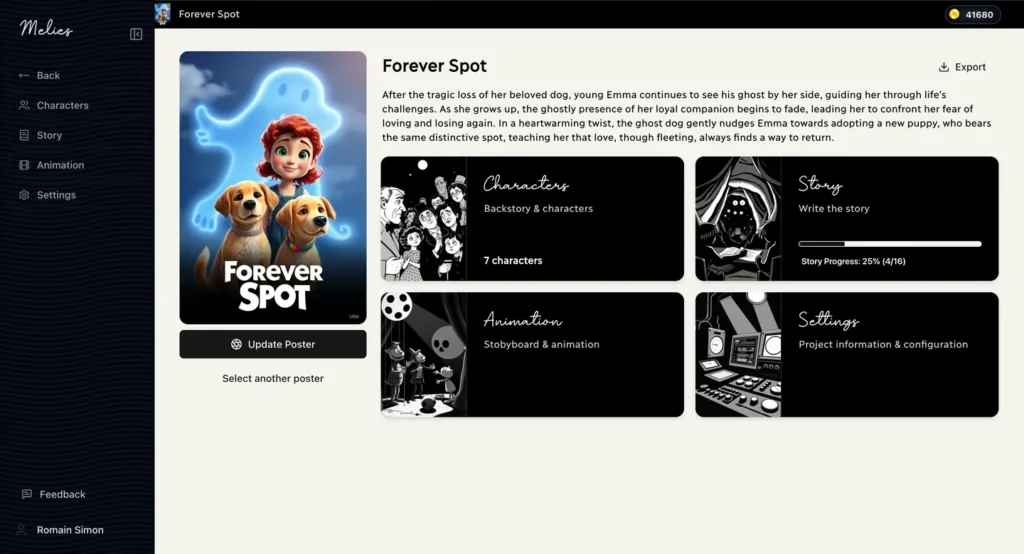
Melies AI is billed as an “AI filmmaking software” that covers idea generation, screenwriting, character creation, asset generation (images, sounds, video), and export into production-ready formats.
Key Features
- Story & idea generator: If you’re stuck at concept or logline stage, Melies offers narrative seeds across genres (shorts, features, series) based on your input.
- Character Bible / arcs: Build character profiles, back-stories, traits, arc progressions. You get assets you can reuse in campaign scripts or video series.
- AI screenwriting + editor: You move from logline → outline → full script within the platform; export formats include PDF, Final Draft (.fdx) and Fountain.
- Asset generation & integration: Beyond text: you can generate images, videos, sound effects, voices, music—all within or integrated with Melies. Example: integration with ElevenLabs voice-tool, image-tool sets.
- Export & production-readiness: Scripts drafted are ready for hand-off to production, or video teams; the export formats support that.
Script Quality
Strengths:
- Because the platform is built for a full film/production pipeline, it helps you apply structure (beats, character arcs, scenes) rather than just “write a script”. That means your draft is closer to usable.
- Asset generation + script writing in one place reduces hand-off friction (drafting → visuals → voice → edit) which is highly valuable when you’re producing multiple branded videos or series.
- The narrative support means you can scale story-led content with fewer manual steps.
Limitations / what to watch out for:
- You still need to infuse your brand voice. The AI gives you a good backbone, but you must ensure the tone (“you/your”), the audience relevance, the marketing hook all align with your strategy.
- If you focus mostly on short, simple video scripts (30–60 seconds, single scene), the full feature-set may be more than you need—or may add complexity.
- The asset-generation features (images, voices, etc) are strong but may require review and editing. For production quality you’ll likely want a human pass.
Pricing
- Indie plan: ~US $29/month. Offers 2,500 credits/month and supports approx one short film (up to ~5 minutes) including AI screenwriting, images, videos, sounds.
- Filmmaker plan: ~US $99/month. 10,000 credits/month; supports ~3 short films or 1 longer film (up to ~15 minutes) plus full asset generation.
- Studio plan: ~US $390/month. 50,000 credits/month; supports 10+ short/long films (up to ~180 minutes) plus full pipeline.
6. Squibler
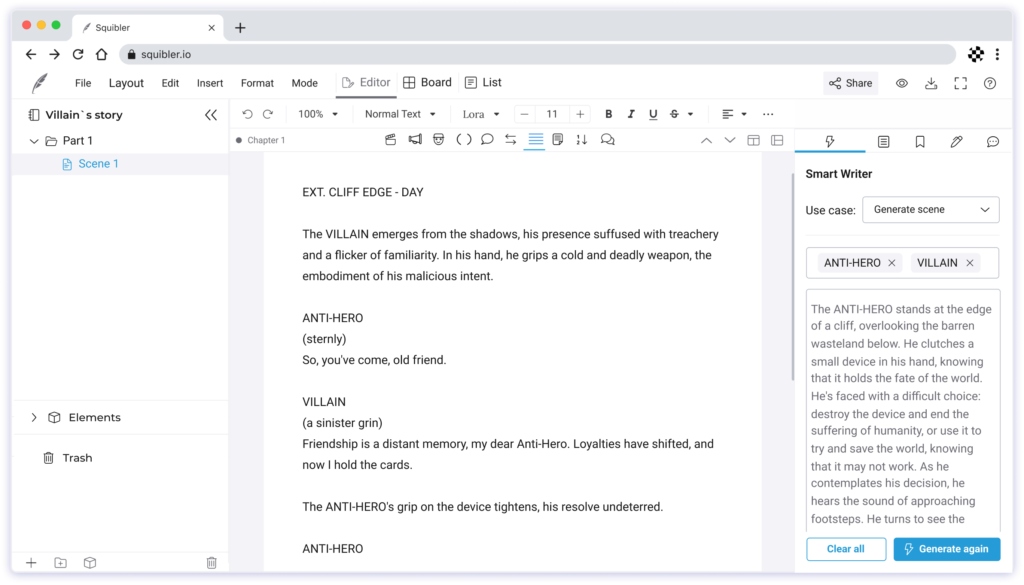
Squibler is an AI-powered writing platform tailored for authors, screenwriters, and content creators working on longer form narrative projects.
Unlike general chat-based AI models, Squibler comes loaded with templates for screenplays, supports editor workflows for characters/settings/scenes, and offers export and collaboration features aimed at narrative workflows.
Key Features
- Script & screenplay templates: You get pre-built structural templates for screenplays, short films, and scripts, so you don’t start from a blank page.
- AI Smart Writer + scene generation: Define characters, settings, plot beats or themes, then let the AI generate scenes or dialogue. It also supports rewriting and scene-expansion tools.
- Element management: Squibler lets you store character bios, setting notes, objects, and export this alongside your script—helpful when you’re juggling brand assets, personas or story arcs.
- Project-tracking & collaboration: For teams or recurring campaign scripts, you can manage file versions, set goals, collaborate in real-time.
- Export and formatting options: You can export drafts to standard formats (DOCX / PDF) and pick up in dedicated screenplay software. The tool isn’t fully end-to-end for production, but it gets you far ahead.
Script Quality
Pros:
- The narrative-specific architecture helps you build scripts faster. Users report being surprised how quickly a draft comes together.
- It supports higher-level story thinking (beats, scene breakdowns) rather than just “generate text here.” That aligns well if you’re sketching video campaigns with narrative arcs.
Cons / caveats:
- The output still needs your voice. The AI may generate a scene, but you’ll want to inject brand-specific tone, audience-relevant insight, and refine dialogue so it doesn’t feel generic.
- If you’re doing production-grade screenplays (industry formatting, production notes, very detailed logistics), you may need supplementary software or human edit. While Squibler supports scripting structure, it’s not a full substitute for specialist tools.
- As with many AI tools, the clearer and more detailed your initial prompt or scene input, the better the draft you’ll get.
Pricing
Here’s a snapshot of Squibler’s pricing and what it means for you:
- Free plan: Offers limited access. Typically up to ~6,000 AI-generated words/month, 5 image generations/month, one project slot, and version history. Good for trialing.
- Pro plan: Starts around US$16–20/month (if billed annually ~US$16/month; monthly rate ~US$20-30) for “unlimited” AI writing, unlimited visuals, and full access to templates and export features.
- Some sources list a “Pro” at US$29/month if billed monthly or US$192/year (~US$16/month equivalent).
7. Synthesia
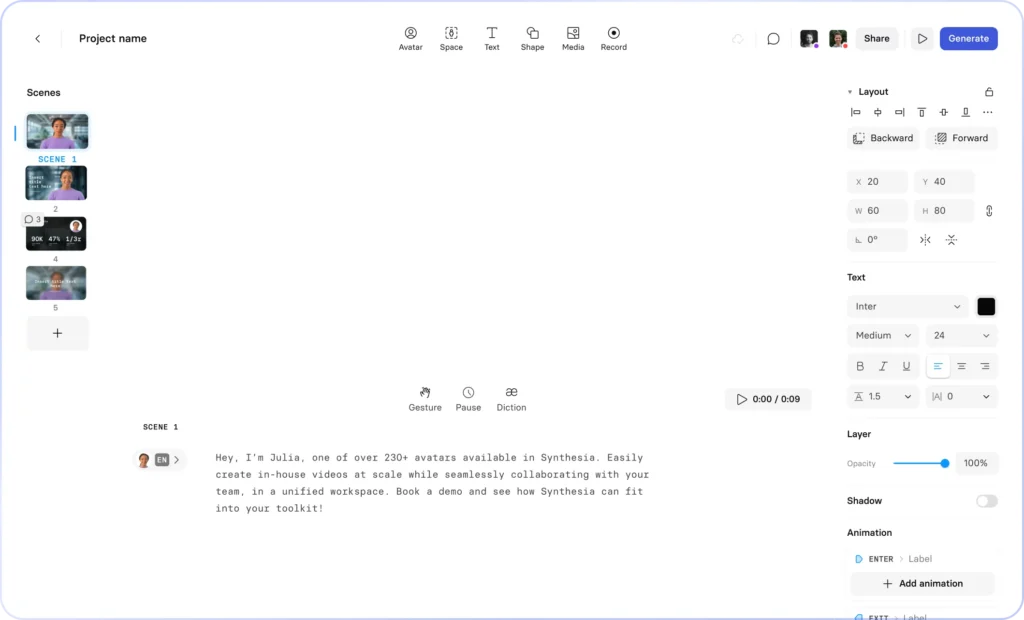
Synthesia is an AI video creation platform that offers a built-in AI script generator alongside text-to-video production. You feed a topic or upload a document, choose a tone/style, and Synthesia will generate a script you can turn into an avatar-led video.
Features
- AI Script Generator: Type a prompt or upload a brief, and Synthesia will produce a script that you can review and tweak.
- Text-to-Video with Avatars and Voice: After you have your script, you select an AI avatar, voice-over language (140+ languages) and create a video. No filming required.
- Templates & Branding Kits: Pre-designed video templates and brand elements allow faster production and consistent identity.
- Multilingual & Localization Support: Translate videos into multiple languages with synced speech and lip-sync for global reach.
- Collaboration & Export Options: Team access, guest review, download-ready videos, integration with LMS or web pages.
Script Quality
- Speed to draft: The AI script generator turns ideas into full script drafts in minutes. That’s a big win when you’re producing multiple video scripts per campaign.
- Structure built-in: Because it’s tied to video production, the draft often arrives with a “hook-middle-CTA” structure, aligned to viewer retention logic—useful for YouTube or marketing videos.
- Voice and presentation: When combined with avatar + voiceover, the result feels more “ broadcast” than static text. That means you must still adjust for your brand voice, audience nuance, conversational tone (you/your) and pacing.
- Limitations: It’s not a full screenplay tool. If you’re working on long-form narrative film scripts or complex branching dialogues, you may find the “script” output a little shallow and still needing human enrichment.
Pricing
Here’s the current pricing snapshot (always check latest from vendor):
- Free Plan: You can start for free—e.g., up to 3 minutes of video/month, access to 1 editor & 9 avatars.
- Starter Plan: Approx US $29/month (billed monthly) or ~US $18/month if billed annually—includes ~10 minutes of video/month, 125+ avatars.
- Creator Plan: Around US $89/month (or ≈ US $64/month when billed annually) for 30 minutes of video/month, 180+ avatars, branding and API access.
- Enterprise Plan: Custom pricing—unlimited video minutes, enterprise features, custom avatar creation, SSO, priority support.






